Tuesday Triage #76
- TUESDAY TRIAGE #76 by Vadim Drobinin
- On holidays
- Things I enjoyed reading
- 1. Precision cooking for printed foods via multiwavelength lasers by Jonathan David Blutinger et al
- 2. Ham Sniffers Are Pushing Their Noses to the Limit by Richard Morgan
- 3. My top 5 home automation projects by Chirag Desai
- 4. The Invention of Santa Claus: From Thomas Nast to Coca-Cola by Anne Prah-Perochon
- 5. Rethinking Kandinsky by David Carrier
- 6. The Psychological Drama of the World Chess Championship by Louisa Thomas
- 7. Five takeaways from looking for a new senior role in tech by @pcalcado
- 8. Heroes of Might and Magic by Jimmy Maher
- 9. Sequencing your DNA with a USB dongle and open source code by Ben Popper
- 10. He Paid $30 for a Drawing. It Could Be a Renaissance Work Worth Millions by Alyssa Lukpat
- Things I didn't know last Tuesday
- 1. Mince pies and sherry for Santa Claus
- 2. Blodplättar
- 3. Watching a lecture at x2 speed twice is better than watching it at normal speed once
- 4. 2.9 billion people are still offline in 2021
- 5. Pineapple burns mouth due to bromelain, not acid
- 6. Mahlab
- 7. Carbonated beverages in Space
- 8. Culinary diplomacy
- 9. Locals in Churchill, Manitoba leave their cars unlocked to provide escape from bears
- 10. Arabic influence on the Spanish language
- Book of the week
- Thank you and see you in a week!
TUESDAY TRIAGE #76
by Vadim Drobinin ¶
Your weekly crème de la crème of the Internet is here!
28.12.2021 (read in browser)
-
Intro
Whatever is on my mind this week. -
Things I enjoyed reading
Ten-ish articles I found worth reading. -
Things I didn't know last Tuesday
Ten-ish facts I didn't know when I wrote the previous edition. -
Book of the week
Some thoughts on the latest book I've read.
On holidays ¶
'tis the season to be jolly, and every December my wife and I exchange small gifts for 24 days in a row. One could call them advents, but our only attempt at burning down a candle with daily marks failed within its first 30%.
Long story short, one of the advents included a flavoured Kit-Kat with some shop's display window and what I learnt to be a dessert called Mont Blanc.
I love cooking obscure things that are not planned, so here it is. My only regret is not using a ready-made chestnut puree as dealing with them was the single painful part of the experience.

While the roasted and cleaned chestnuts are boiling with sugar and vanilla, I made a few pâte sablée tarts.
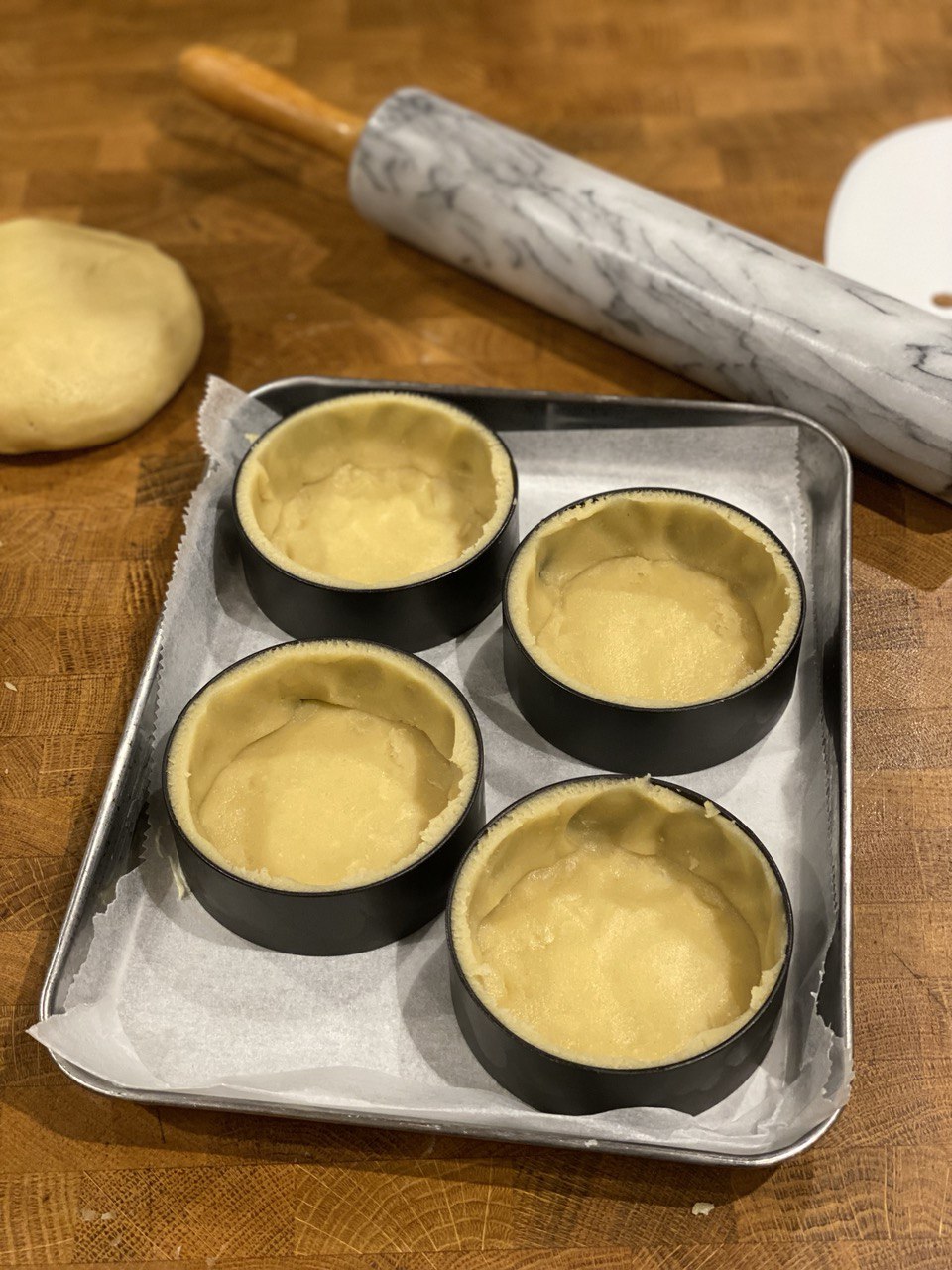
Then filled them with a mixture of whipped cream and meringues:
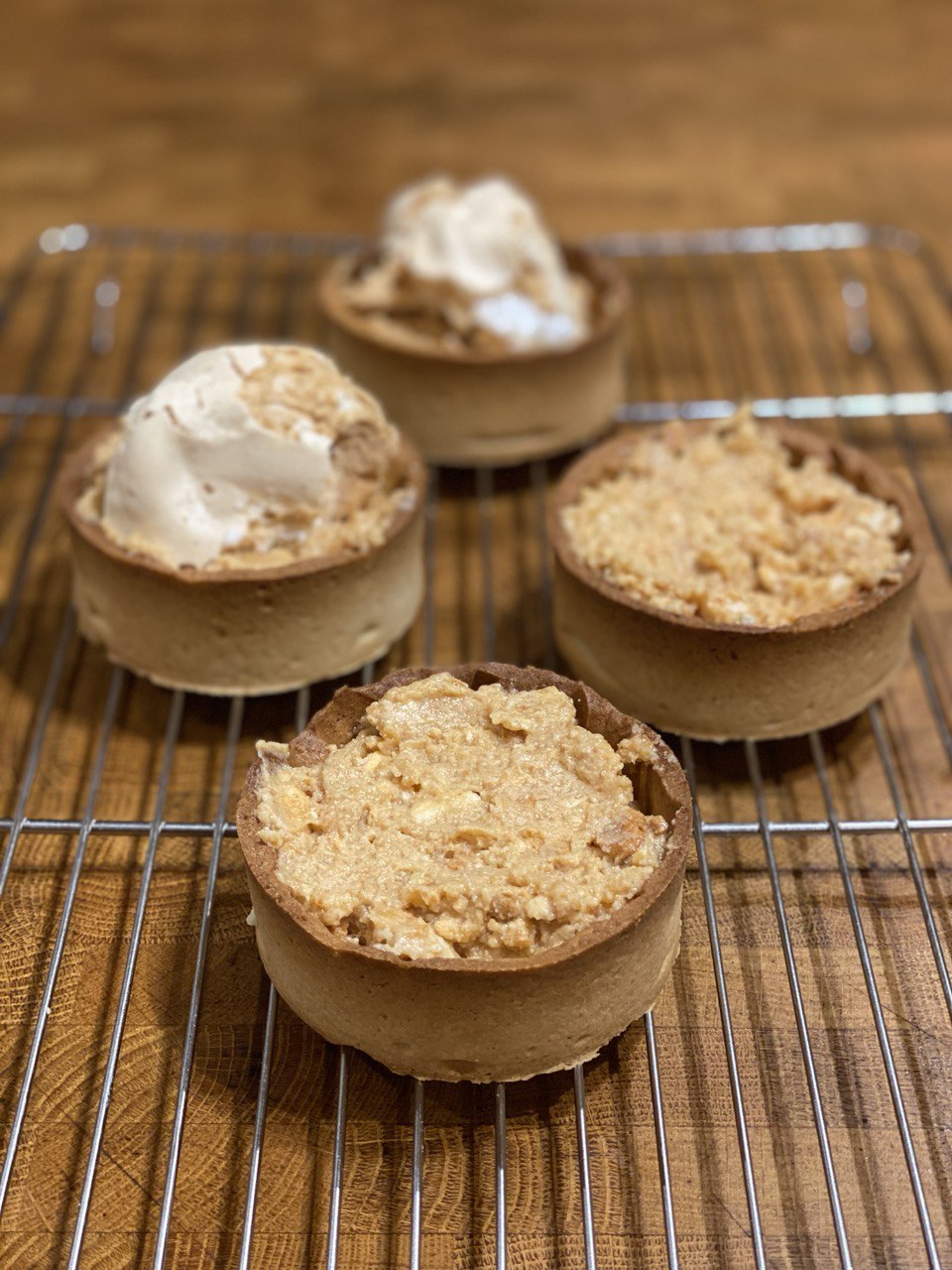
Finally, decorated with chilled chestnut puree and icing. Pretty flavourful and not too sweet, which is a surprise. The Kit-Kat in question is present too:
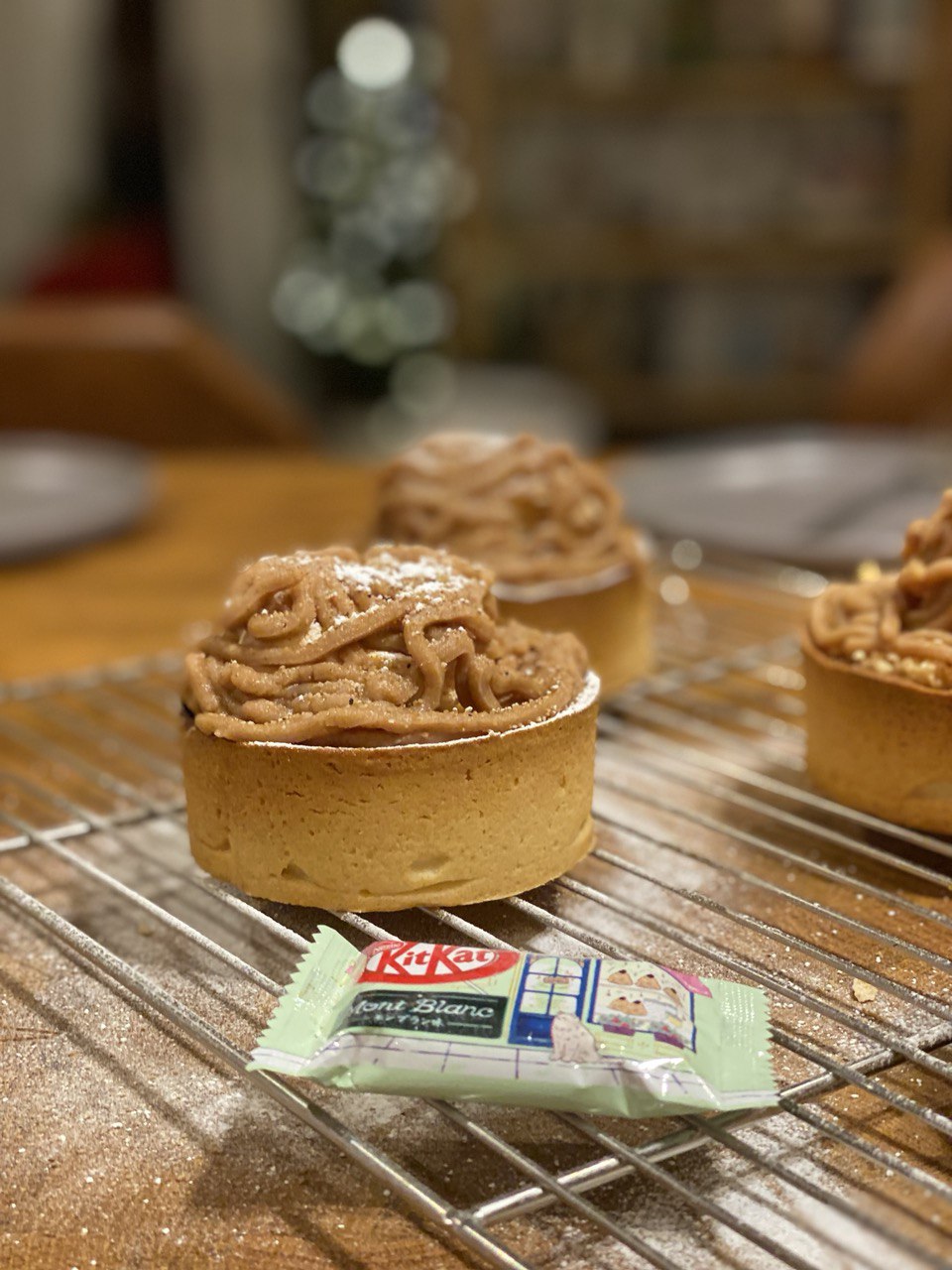
And as that's the season, we caught up with a few friends over a dinner, which was an excuse to lightly smoke grey mullet:

As well as make a non-alcoholic egg nog in a sous vide, which leaves way less mess but also calls for a few hydrocolloids to make the liquid thicker.
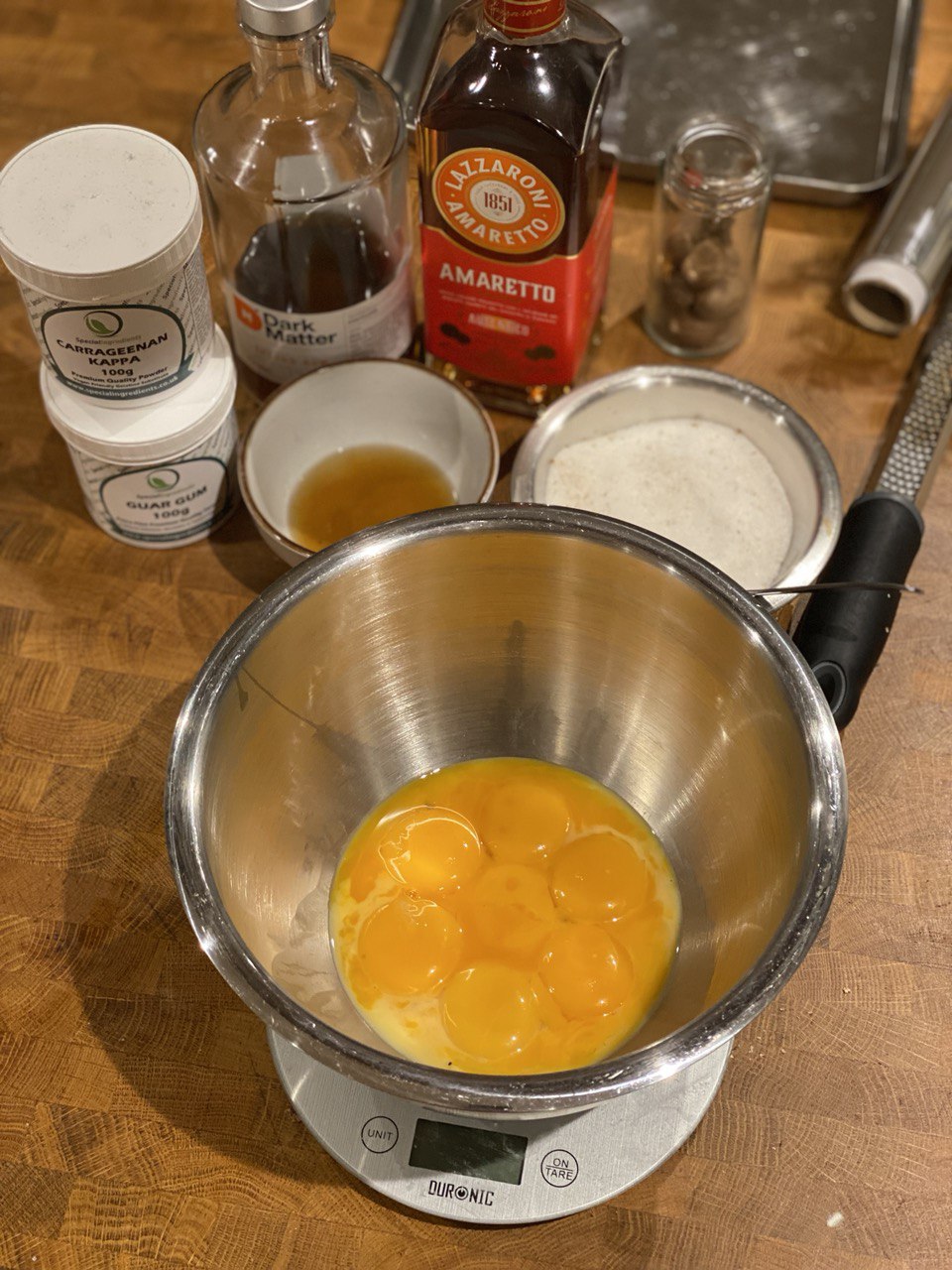
I also tried out a new recipe for mussels, boiled in white wine first, which is classic:
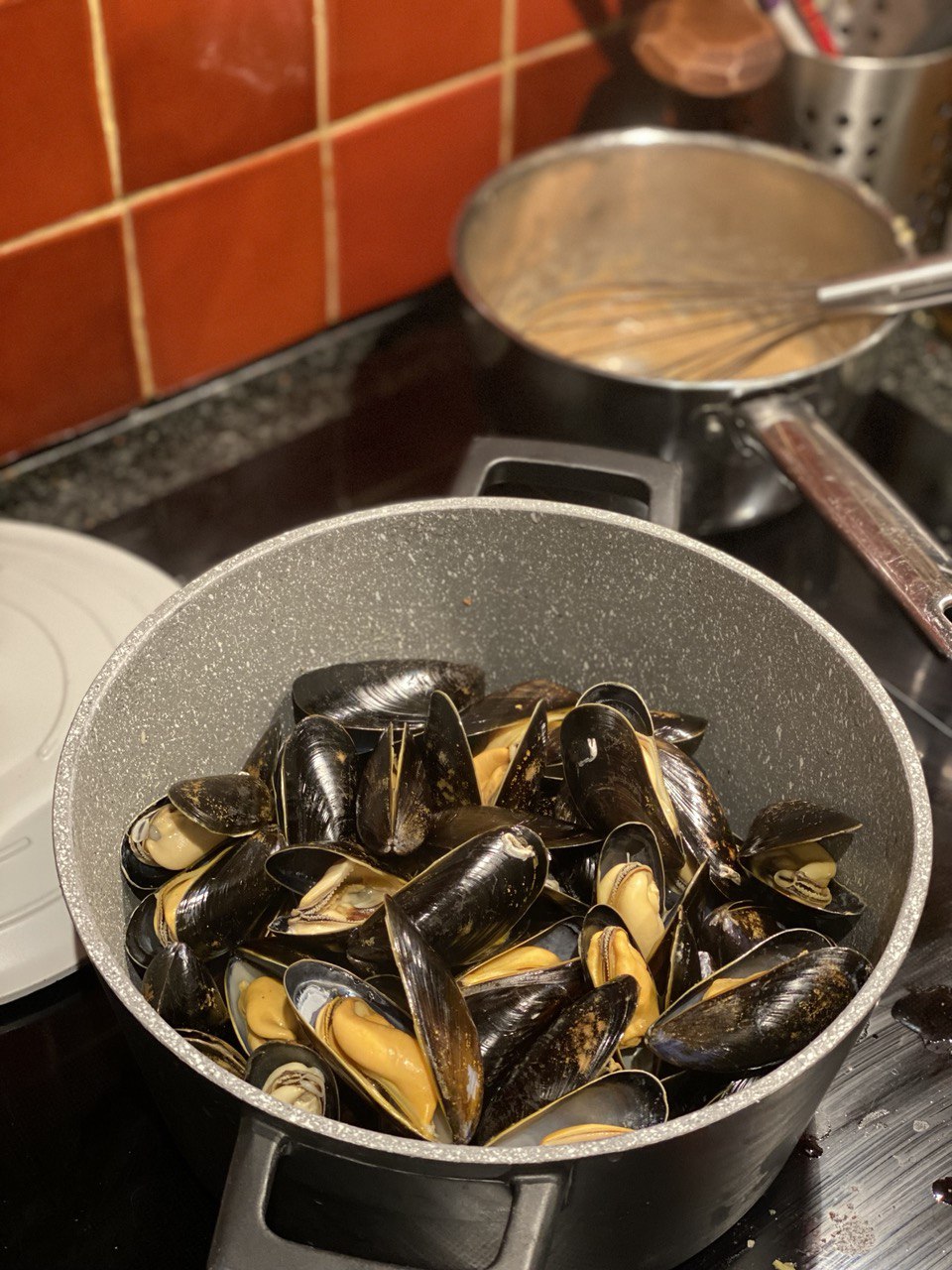
But then plated with herbs, deglased shallots, and warm Guinnes foam on top.
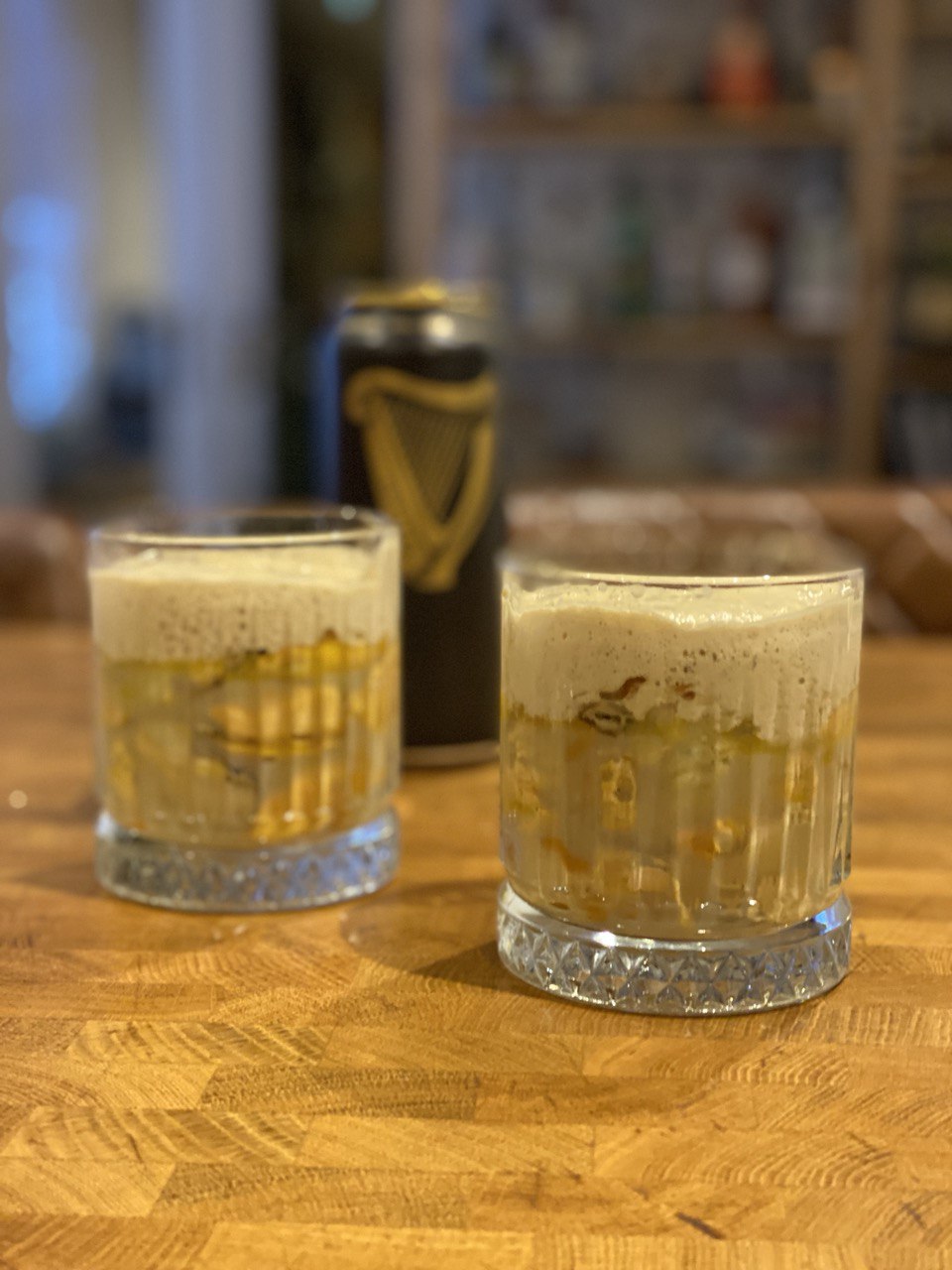
And this is a wrap for now, although I somehow managed to cook a bit more this week.
See you in 2022?
Things I enjoyed reading ¶
1. Precision cooking for printed foods via multiwavelength lasers by Jonathan David Blutinger et al ¶
As someone almost equally curious about both cooking and modern technologies, I couldn't pass by the recently published paper on problems of cooking the food printed layer-by-layer.
We fully cooked two separate samples of printed chicken using a blue laser and an electric range for taste-testing. Two taste-testers were given two plates: (Sample 1) printed chicken cooked using a blue laser, and (Sample 2) printed chicken cooked on an electric range. We did not tell the testers how each sample was cooked but they were aware that one sample was laser-cooked and one sample was range-cooked. Each tester was instructed to taste each sample and describe all sensory reactions.
You see, printing food on its own is not a novelty today: even my 3D-printer supports attachements that turn it into something capable of turning chocolate into objects of all possible shapes. But once you try layering something more complex, like raw chicken, you might as well consider cooking it for a bunch of reasons, e.g to prevent bacteria from staying between the layers. And that seems to be still hard to solve.
2. Ham Sniffers Are Pushing Their Noses to the Limit by Richard Morgan ¶
I somewhat expected this article to be about something completely different, but in fact it is about jamon and people who use their noses to spot the meat that goes wrong, which is really cool.
Mr. Vega’s boss, cellar quality-control chief Cristina Sánchez Blanco, 44, detailed the test required to become a sniffer. Aspirants must detect minute, varying concentrations of five liquids in water—ammonia, gin, wine (usually fino sherry), rubbing alcohol and vinegar.
The ratio can be, at maximum, 5 milliliters per liter or as infinitesimal as 0.8 milliliter, a range of roughly 75 to 12 drops in a standard 750 milliliter wine bottle.
Also seems like I am not going to pass their entrance exams any time soon.
3. My top 5 home automation projects by Chirag Desai ¶
I wrote about my endless fight with home automation a few times (the latest is, I discontinued by smart heating as it was too unrelyable, and also in the process of resetting the network setup which is painful as hell), but there are also success stories:
In the UK, rubbish and recycling is collected on the same day each week. Bank holidays usually move our collection day back by a day. My smart home keeps track of public holidays and provides a reminder the day before collection. The bins are generally collected before I am awake and need to be out on the edge of the property before morning.
There is a bunch of other ways to solve the problem in the quote, but this one pretty much turns the home assistant into a source of truth which I bet is very convenient.
4. The Invention of Santa Claus: From Thomas Nast to Coca-Cola by Anne Prah-Perochon ¶
I couldn't get away from at least one true to the season article in this week's newsfeeds, so here is a story of Santa Claus:
In 1875, Louis Prang, the father of the American Christmas card, printed a series of postcards with a Santa Claus in a red costume. Did he invent the costume’s red color? Probably not, but he is the one remembered in history. In 1931, Coca-Cola decided to broaden its market to children. The Atlanta-based company asked Haddon Sundblom, an illustrator of Swedish descent, to depict a paunchy, smiling Santa Claus, dressed in red, with ruddy cheeks and an elfish look.
As someone who grew up in a country without a jolly Santa Claus but with a stern and rough Father Frost, I always thought Coca-Cola ads make him wear the red costume to look better with their bottles, but apparently these two things are at least somewhat related.
5. Rethinking Kandinsky by David Carrier ¶
There are not that many painters whose works I enjoy, and Kandinsky never was among them, but this article at least gave me some background, which in turn slightly shifted my perspective.
Unusually at such a retrospective, viewers can place the works in some sort of visually obvious chronological order. But it’s not easy to reconstruct the development of Kandinsky’s career, or understand the significance of the individual paintings. Until fairly recently, the works of Kazimir Malevich, Vladimir Tatlin, and the other pioneering Soviet abstractionists were relatively inaccessible, and the important Swedish painter Hilma af Klint was totally unknown.
Learning about art is pretty hard because it is very subjective. Even music has more logic to it (think harmonies and so on).
So for me the only way to get at least a glimpse of it is to listen to people who have a very strong opinion about specific painters, but I do wonder if there is more to it.
6. The Psychological Drama of the World Chess Championship by Louisa Thomas ¶
It's been a while since I played chess competitively, but reading about competitions never gets boring, and the most recent world championship proves it (despite the majority of games being by-the-books-boring).
The endgame was a complicated setup: Nepomniachtchi had his powerful queen, and Carlsen had a rook, a knight, and two pawns. With perfectly correct play, the contest would result in a draw. But, in practice, it was a difficult position for the queen to hold—particularly against Carlsen, who was moving his pieces in harmony. Nepomniachtchi made one inaccurate move, and, after nearly eight hours and a hundred and thirty-six moves, that was all that Carlsen needed to win what had become the longest game in World Championship history.
I am not very surprise Carlsen won again, but I am surprised a bit, as this is his 8th year in a row of holding the title.
7. Five takeaways from looking for a new senior role in tech by @pcalcado ¶
Here is a selection of some very good advice about looking for a new role. Someone I respect said once, that engineers never stop looking for their new adventure, which is partly true, but looking actively is a completely different story, and having a few independent but well-versed headhunters on your side might be handy.
When I started in this industry, headhunter meant something specific: a recruiter for senior and/or hard-to-find positions. These days we use the term to refer to any independent recruiter that gets paid handsomely when they fill a position. Even when I am not looking for a new job, I try to at least skim over every recruiter email I get. As you undoubtedly have experienced first-hand, the vast majority of unsolicited messages from recruiters is irrelevant, and badly automated spam. Still, now and then, a recruiter seems to have invested five seconds trying to research you and really thinks the position would be a good fit. These you want to build a relationship with, even if you are not looking for a job yet.
I also really like how the author kept track of all interactions with companies in an Excel spreadsheet: such data might be handy even a few years later during the next move.
8. Heroes of Might and Magic by Jimmy Maher ¶
As with chess, it's been a while since I last played HoM&M, and when I did it was their 3rd edition: the last one before they ruined it with "modern" graphics, but also modern enough to run smoothly on most screens.
This is a very joyful read anyway:
But instead of merely increasing all of the computer players’ relevant numbers by 50 percent or more, as so many strategy games of the 1990s did, Heroes cheats in a way that isn’t so obviously egregious: its computer players suffer from no fog of war, meaning they know where every resource and castle is on the map from the start and can react accordingly. The resulting competition remains decidedly asymmetrical, but it feels like a struggle against deviously clever opponents rather than blatantly cheating ones. And at the end of the day, the subjective feel of the experience is all that matters.
Given the holidays are still going on, I might as well spend a day (or two) giving it another try. Also maybe Duke Nukem 3D and Quake.
Good games never age.
9. Sequencing your DNA with a USB dongle and open source code by Ben Popper ¶
When I graduated with a thesis on DNA reconstruction, sequencing it at home was a very expensive and inaccurate adventure. These days it is as straightforward as buying a kit and throwing money at non-reusable parts: so still expensive, but not inaccurate anymore.
However, seems like there is also a way to make it way less expensive:
In fact, during a normal sequence, you are likely to want to sequence the genome more than once, since any sample you take has a random collection of DNA molecules, and may not contain the parts you are most interested in. With the ability to select, you can winnow down what you’re looking for faster and avoid sequencing other areas over and over again.
I am probably not ready yet to get a nanopore sequencer yet, but maybe by the next December it will be even cheaper?
10. He Paid $30 for a Drawing. It Could Be a Renaissance Work Worth Millions by Alyssa Lukpat ¶
Checking out charity shops (which is what we call thrift- and second-hand stores here in the UK) is a fun activity, especially given the variety of unexpectedly good books you could find there, but I never consider it to be profitable as well (expect that one time when we found one of the very first Harry Potter prints).
The declaration that the drawing was the work of Dürer — an assessment that is not universally shared among researchers — came about as a result of a chance meeting and the efforts of a dogged art dealer who amassed thousands of frequent-flier miles tracking down an answer.
This lucky fella might have an even better deal though.
Things I didn't know last Tuesday ¶
1. Mince pies and sherry for Santa Claus ¶
I didn't even question the thought that here in the UK children greet Santa Claus the same way as the kids across the pond.
I was wrong: they just leave some booze for the dude, and it raises concerns across doctors:
Father Christmas could be doing serious harm to his health by overloading with mince pies and sherry, a leading doctor has warned.
Professor Helen Stokes-Lampard, head of the Royal College of GPs, said Santa could face a raft of health issues because of his diet and busy schedule.
I must say, a mince pie is a great replacement for a mere cookie, but sherry is definitely way better than milk, so I can't really blame kids' parents.
2. Blodplättar ¶
My collection of bizzare dishes is growing:
Blodplättar (in Swedish; veriohukainen, verilätty or verilettu in Finnish; verikäkk in Estonian), or blood pancakes in English are a dish served in Finland, Estonia, Sweden and Norway made of whipped blood (typically reindeer blood), water or pilsner, flour and eggs.
I am quite disappointed that these are not really pancakes, just a type of a black pudding. Could be even more bizzare:
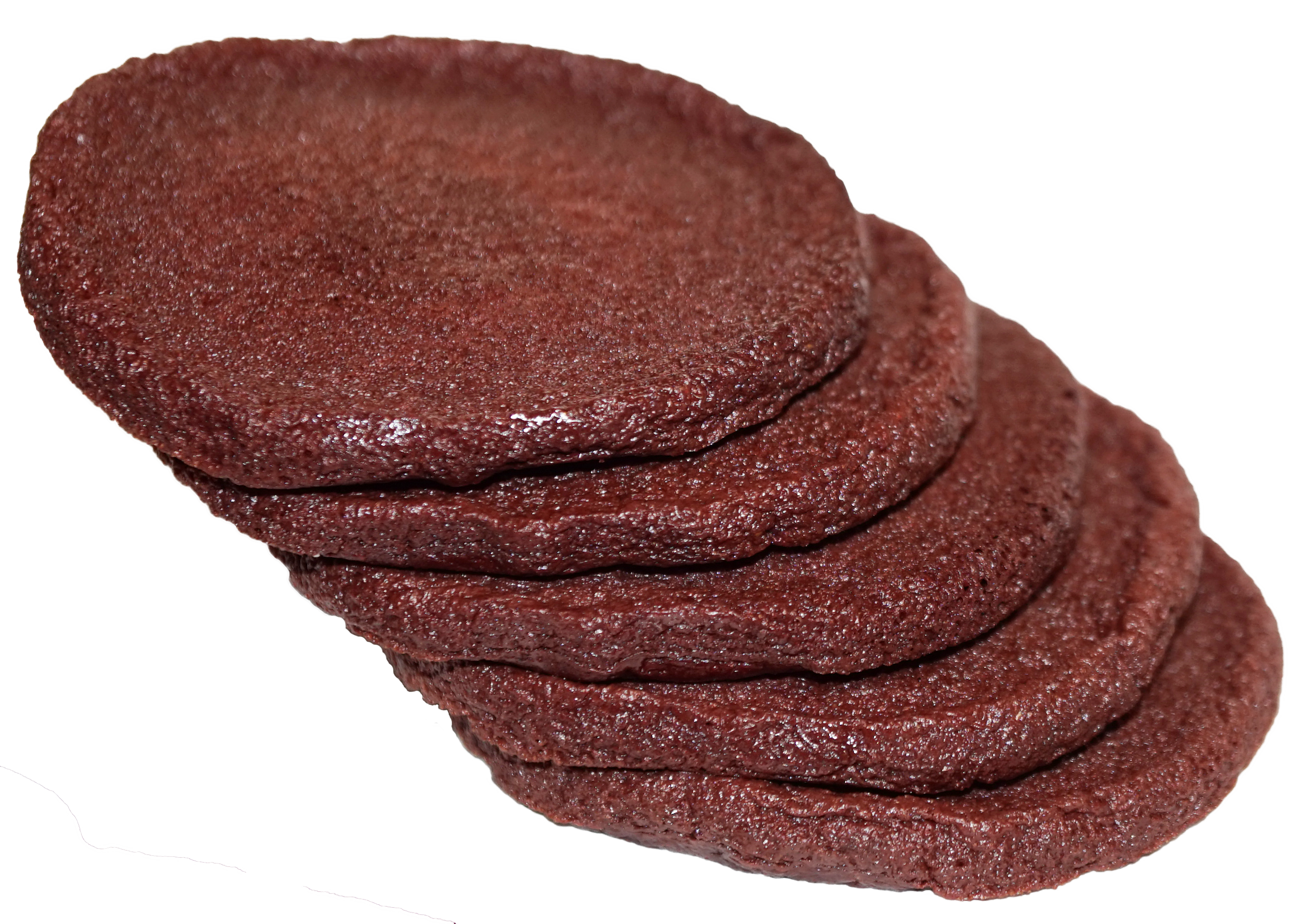
3. Watching a lecture at x2 speed twice is better than watching it at normal speed once ¶
Wish I knew this lifehack during my uni years:
So, a student could just watch videos at 2x speed and halve their time spent on lectures….Or, according to the results of other studies reported in the paper, they could watch a video at 2x normal speed twice, and do better on a test than if they’d watched it once at normal speed. The timing mattered, though: only those who’d watched the 2x video for a second time immediately before a test, rather than right after the first viewing, got this advantage.
But then again, there weren't that many recorded lectures during my uni years.
We also had a few professors who definitely suspected that talking twice faster might make us smarter quicker, but used it in a wrong way.
4. 2.9 billion people are still offline in 2021 ¶
Some mindblowing facts: 37% of the population never used the Internet.
An estimated 37 per cent of the world’s population – or 2.9 billion people – have still never used the Internet.
Yes, 96% are coming from developing countries, but even then: almost four people out of ten?
5. Pineapple burns mouth due to bromelain, not acid ¶
I knew about enzymes in kiwi and pineapple, as they're commonly used to tenderize meat, but never thought that the burning mouth sensation is not some acid but the same enzymes tenderizing my own mouth.
Pineapple contains the enzyme bromelain. It breaks down proteins and it’s an excellent meat tenderizer. It’s also what makes your mouth tingle, burn and maybe even bleed. This is because bromelain is trying to break down the proteins in your mouth, so when you eat pineapple, it’s pretty eating you back.
Sounds rather scary now.
6. Mahlab ¶
Another somewhat scary ingredient: a spice made out of cherry pits' contents.
Mahlab is a powder made from the seeds of the St. Lucy's cherry, found in different parts of the Mediterranean, that requires drying and cracking open rock-hard cherry pits. But if you've ever had a dessert made with whole roasted cherries, where the pit imparts an inimitable depth of flavor, it's easy to see why people go through the trouble.
The taste sounds really interesting, but cherry seeds contain cyanide, so eating a mahlab paste with a spoon is probably not a great idea.
7. Carbonated beverages in Space ¶
Apparently drinking anything carbonated (beer, Coke, or Champagne?) in Space is hardly possible:
The bubbles of carbon dioxide in carbonated beverages aren't buoyant in a weightless environment, so they remain randomly distributed throughout the fluid, even after swallowing. This means that carbonated beverages including soft drinks and beer may become a foamy mess during space travel.
Kind of explains why we didn't move to other planets yet.
8. Culinary diplomacy ¶
Wish I knew about it in high school, thinking of my future occupation.
Culinary diplomacy, gastrodiplomacy or food diplomacy is a type of cultural diplomacy, which itself is a subset of public diplomacy. Its basic premise is that "the easiest way to win hearts and minds is through the stomach".
These days I do my best at winning hears and minds through the stomach though, so might be just that I am a natural at it without even studying.
9. Locals in Churchill, Manitoba leave their cars unlocked to provide escape from bears ¶
Being a car thief in Manitoba seems to have its benefits.
Many locals even leave their cars unlocked in case someone needs to make a quick escape from the polar bears in the area.
On the flip side, there are polar bears roaming around.
10. Arabic influence on the Spanish language ¶
Around 8% of modern Spanish words came from Arabic, and they often begind with "a-" or "al-":
The Spanish words beginning "a-" or "al-" is from the Arabic definite article "al-" (-الْ) referring to the grammatical article English "the".
And yet Al Pacino is American, if you were wondering.
Book of the week ¶
One of my most recent cooking projects is an attempt to eventually empty out all three freezer we somehow managed to stock up in less than a year.
It involves a careful combination of tracking and substion of other ingredients here and there, but also gives a funny perspective at 99% of recipes in ordinary books out there, and certainly changes the way one thinks of them.
As you could have noticed through most books I share about, recipes calling for "classic" pairings don't really entertain me anymore.
There is nothing bad in them, but people get so used to serving their steaks with asparagus all the time, it ruins their capabilities of thinking out of the box.
Michael Pollan looks into this and many other impacts of different food choices in The Omnivore's Dilemma:
For something people profess to like so much, grass is peculiarly hard for us to see. Oh, you can see it well enough in a general sense, but how much do you really see when you look at a patch of grass? The color green, of course, perhaps a transitory recording of the breeze: an abstraction. Grass to us is more ground than figure, a backdrop to more legible things in the landscape—trees, animals, buildings. It’s less a subject in its own right than a context. Maybe this has to do with the disparity in scale between us and the uncountable tiny beings that make up a pasture. Maybe we’re just too big to see what’s going on down there in any detail.
This "backdrop" easily turns into a "field of herbs" the moment you decide to look closer, and sometimes that look is only one pot of rosemary away.
The power of a good cook is not in closely following a recipe the first time they use it – it is in being brave enough to change something accordingly the next time the give the same recipe a try.
And that brings me to modernist cuisine books, where this line of thinking won't work: changing one hydrocolloid might as well turn your dessert into a soup.
Now that is the real fun.
Thank you and see you in a week! ¶
If you have any questions, or want to suggest a link for the next newsletter, please drop me a message on Twitter or reply to this email.
Cheers! 🍸